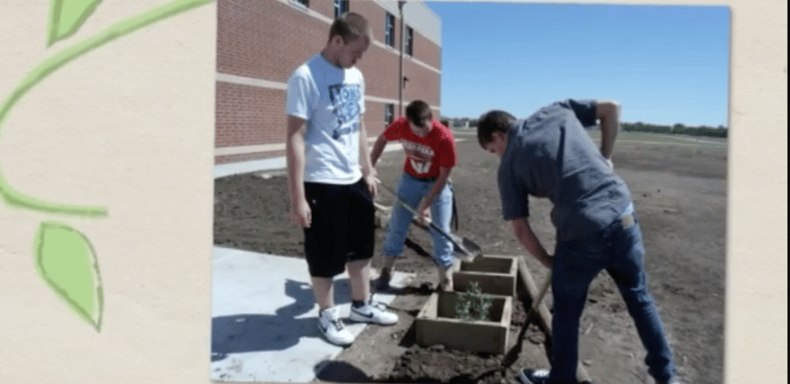
We all know that children belong outdoors, but when they become our students, the tendency is to keep them behind four walls tied to electronic devices, PowerPoint lectures, and computers. Well, I am here to tell you that you can go outside with students and see productive results. Moving your class outside engages a world of fresh stimuli for the senses that have the amazing ability to open up students to new insights and real-life application of the concepts they are learning.
Studies have indicated that when students spend time outside they are healthier, happier, more creative, less stressed, and more alert. Several recent studies have even shown that time in nature or green spaces also helps to reduce ADHD symptoms.
So with that in mind, our high school developed an award-winning, on-campus outdoor wildlife learning site filled with native flowers, native grasses, and even critters—some who now call this space their home, and others using it as a migration stop due to the newly created natural habitat.
Getting Students Involved
We started by first learning about soil and native plants with the goal of creating an on-campus outdoor learning space—a real-life application of why we learn new things. A great resource to learn why soil is so important can be found at https://www.soils.org/iys/monthly-videos. Many of my high school students had never had their hands in soil (yuck, dirt!), used a shovel, or started plants from seeds before taking my class. In fact, the students were so disconnected with their natural world that they were a little afraid of it. Richard Louv coined the phrase "nature deficit disorder" to describe this human alienation from the natural world in his 2005 book Last Child in the Woods.
After our native plant, corn, and wheat seed planting activity, my high school students would go into the greenhouse daily to see the progress of their plantings, skeptical if anything would happen. Then, a few days later, a small green stem emerged and the excitement among my students was overwhelming. Tending to, measuring growth, and watering their seedlings became a positive part of each class period. Posting “life of my plant” photos, time-lapsed growth videos, and other digital media engaged the students even more as they documented the life cycle of their plants. Soil analysis labs with real-life applications to our plant projects brought in the chemistry element—a sneaky way to engage those who elected not to take chemistry because they thought it would be too difficult. Agricultural aspects were also included in the class, so nutrient needs, photosynthesis, plants as carbon sinks, biomass fuels from corn, and biogeochemical cycles became a part of the norm.
Experiencing Science as It Happens
By using CO2 and oxygen monitoring devices, students discovered that the parking lot with concrete-covered ground had low oxygen levels and higher CO2 levels than the grassy area in front of the school, and still lower CO2 levels and higher O2 levels upon entering the tall grasses section. Why? Photosynthesis! It was no longer an equation on the class white board—they were actually documenting how plants and ground covers withdraw CO2 from the atmosphere to create sugars for the plants and expel oxygen for us. If you have access to the Labdisc portable lab, here is a great hands-on photosynthesis experiment you can try out.
I then applied for a Toolbox for Education grant from Lowe’s for funding to create our 4,000 square foot “Legacy for Learning Native Plant Gardens and Native Grasses Outdoor Wildlife Learning Site” on the school campus. This funding helped us purchase the necessary tools, plants, elevated garden structures, mulch, and other supplies. Twenty-first century skills such as critical thinking, problem solving, and communication came into play as the students began constructing the outdoor learning site. The students took pride in their work, which has resulted in no vandalism at the site.
Giving Students the Chance to Engage With the Community
An added benefit is community engagement. Our native grasses space and gardens are open to both the public and the students within schools adjacent to the site. My students researched information and used their computer graphic skills to create signage to help visitors learn about heat islands, carbon sinks, biochemical cycles, plant identification, and more. A local Boy Scout Eagle Award project helped create a QR code nature trail in the native grasses space. My ecology students wrote the text for each of the 25 nature trail signs that take walkers on a trek using their smartphone QR code reader app.
Students constructing birdhouses and other habitat enclosures to place into the site also applied mathematics and engineering design elements learned from other classes. Annual water quality tests were created for the run-off pond, bio blitz data regarding the changes in biodiversity as native habitat was developed, and further plantings of native species continue the student use in biology, ecology, and other science AP classes as the legacy for this learning site.
You can see a video of our accomplishments on the Eisenhower High School Ecology Class page on Facebook or at https://animoto.com/play/bZhr346baZ5od7DgENYxHg. This award-winning student site has also contributed to our high school being named one of America's Top 10 Eco-Schools by the National Wildlife Federation.
Looking for more engaging science lessons? Check out the complete library of hand-on experiments available for the Labdisc!